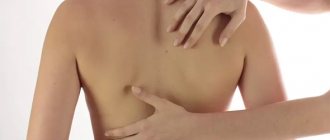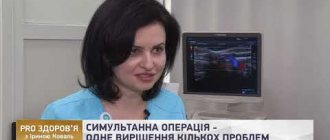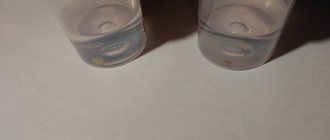Shingles or herpes is an infectious disease that causes damage to the skin with the appearance of characteristic rashes. The causative agent of the infection is the varicella zoster virus, which is in a latent state in the patient’s body.
After a person has had chickenpox, the virus becomes inactive and can persist in the cells of the spinal cord for decades. Its reactivation against the background of decreased immunity leads to the appearance of symptoms of herpes zoster.
Main symptoms of the disease
Herpes zoster mainly occurs on the body. At first it looks like pink spots. Soon they quickly become inflamed, turn red, and become covered with small blisters with transparent contents. Over time, the spots dry out and become crusty, and later they fall off.
The disease is characterized by severe attacks of pain, which can worsen at night.
Other signs of the disease:
- temperature rises to 39°C;
- painful rashes;
- headache;
- trembling and coldness in the body;
- runny nose (in children).
What is shingles?
Shingles is a common viral disease diagnosed in people who have previously had chickenpox (chickenpox). The infection occurs more often in older people, which is associated with an age-related decrease in immune defense.
The development of shingles can be triggered by:
- uncontrolled medication use;
- radio and chemotherapy;
- hypovitaminosis;
- intense physical or mental stress;
- unfavorable environmental situation;
- prolonged exposure to allergens or toxic substances (for example, at work);
- a sharp change in climate zone;
- hypothermia of the body;
- chronic diseases, for example, diabetes, stomach ulcers;
- undergone surgical operations.
The risk of developing herpes zoster is higher among people suffering from autoimmune diseases and cancer.
The symptoms of the disease depend on its stage and the individual characteristics of the patient’s body. The incubation period can last decades, after which the virus is activated against the background of previous injuries, acute infections or other factors that weaken the immune system.
In a latent state, the pathogen is located in the spinal cord, but when the body’s defenses decrease, it begins to actively multiply and infect surrounding tissues. As a rule, the virus “moves” along the nerve endings to the skin, where it manifests itself in the form of a characteristic rash. At the same time, the infection spreads throughout the nervous system, including the brain, which causes attacks of pain and symptoms of general intoxication.
The first signs of shingles are:
- malaise and general weakness;
- increased fatigue;
- fever;
- headache;
- loss of appetite accompanied by nausea, in severe cases with vomiting.
After a few days, characteristic pain appears in the affected area of the skin. Painful sensations can be of varying intensity, intensify when touched, and be accompanied by itching.
In this case, the symptoms change, the following occurs:
- swelling and redness of tissues;
- rash in the form of reddish bubbles (vesicles) filled with liquid. The bubbles can grow and merge with each other.
After 3-5 days, the blisters shrink and disappear, often with the formation of scars.
Dermatologists distinguish several types of atypical shingles, in which the manifestations of the infection change:
- abortive - characterized by the absence of rash and pain, although the skin swells, but redness and swelling quickly disappear;
- bullous - instead of small blisters, the patient experiences large formations, and the symptoms of general intoxication intensify;
- hemorrhagic - the rash is filled with lymph with a large amount of blood, microhemorrhages occur in the skin, the pathological process affects the deep layers of the skin;
- gangrenous - deep and long-lasting ulcers appear at the site of the rash, the general condition of the patient is serious;
- generalized - the rash occupies up to half the body and can appear on the mucous membranes (for example, in the oral cavity).
The severity of the disease is directly related to the general state of the immune system. In older people, people suffering from severe chronic disorders, and those who have undergone radiation therapy, the infection is most acute and often leads to complications.
Methods of treating the disease
Herpes zoster on the face and other areas is treated on an outpatient basis. Inpatient treatment is required only for the generalized form, as well as complications.
The peculiarity of therapy is its complexity - taking antiviral and immunostimulating medications.
Therapy involves relieving intoxication and pain, preventing the progression of infection. For secondary bacterial infections, antibiotics are used. To relieve rashes, use brilliant green and 5% dermatol ointment locally. If the process is sluggish, the doctor may prescribe metacil ointment or solcoseryl.
For herpes zoster on the neck or other areas, physiotherapeutic procedures are also sometimes prescribed.
Diet is important for the effectiveness of therapy. Exclude from the diet:
- fat meat;
- animal fats;
- spicy foods.
Where does shingles occur?
The location of the rash depends on which nerve is affected. The rash may appear on the face, torso, and limbs, but usually only on one side of the body: for example, only on the back or only on the stomach. If vesicles appear on both sides, this indicates a rare generalized form of herpes zoster.
The rash may also affect:
- ears;
- mucous membrane of the mouth and nose;
- conjunctiva of the eyes;
- external genitalia, including the vulva in women.
If bubbles appear on the mucous membranes, they quickly burst with the formation of areas of erosion.
Prevention
Disease prevention – strengthening the immune system:
- healthy lifestyle;
- hardening;
- regular physical activity;
- proper nutrition;
- proper rest, sleep.
Despite the fact that water procedures during the treatment of herpes zoster are contraindicated, the complication of the disease is caused by poor hygiene. Therefore, it is important:
- avoid taking hot baths - prefer a warm, short shower;
- exclude washcloths, cosmetics and anything that can irritate the skin;
- just blot the inflamed areas;
- use 2 towels - one for healthy skin, the other for infected skin (change daily).
If the disease progresses, you should limit yourself to wet wipes, and do not wet the damaged skin. When the ulcers turn into crusts, you can take a shower.
In any case, treatment is prescribed individually and exclusively by a doctor.
IMPORTANT:
Self-medication can aggravate the disease and provoke life-threatening consequences.
Other articles by the author
- Pyoderma
- Herpes zoster
- Pityriasis rosea
- Shingles
How is shingles transmitted?
You can get shingles from someone who has herpes or chickenpox. However, if the patient comes into contact with this virus for the first time, he will get chickenpox, and not shingles. The appearance of lichen is possible only in the case of a secondary lesion.
Most often, the pathogen is transmitted by airborne droplets; contact infection is also possible.
When the virus is inhaled, it remains in the respiratory tract and begins to spread throughout the body along with the flow of lymph and blood, as well as moving along nerve endings. Gradually, the pathogen penetrates most tissues of the body. This explains the recurrent nature of herpes zoster - it is impossible to suppress the virus with self-medication; complex therapy is required under the supervision of an experienced dermatologist.
Folk remedies
All of the following recipes for plant herbs (optional) are prepared as follows: leave one tablespoon of herbs in a glass of boiling water for 20-30 minutes, cool and consume 1/2-1/3 cup 2-3 times a day to relieve mild pain and nervous excitability , as well as for insomnia.
- Valerian root, mint leaves - 3 parts each, watch leaves - 4 parts.
- Mint leaf, watch leaf - 2 parts each, valerian root and hop cones - 1 part each.
- Fennel fruits and chamomile flowers - 1 part each, marshmallow root, licorice root, wheatgrass rhizome - 2 parts each (recommended for children).
- Valerian root – 2 parts, chamomile root – 3 parts, caraway fruit – 5 parts.
- Valerian root, hawthorn flowers, mint leaves, mistletoe herb, motherwort herb - 1 part each.
- Valerian root, motherwort herb, green oat straws - 1 part each.
- Tatar leaves, green oat straw, caraway fruits - 2 parts each, hawthorn flowers, chamomile flowers - 1 part each.
- Mint leaves - 1 part, heather grass, lemon balm leaves - 2 parts each, valerian root - 4 parts.
- Heather leaves, cudweed herb, thyme herb, valerian root - 2 parts each, chicory root - 1 part.
- Motherwort grass, cudweed grass, heather grass - 2 parts each, hop cones, caraway fruits - 1 part each.
The use of medicinal pharmacopoeial herbs is justified in mild forms of the pathogenesis of herpes zoster.
HSV2 genital herpes
Primary infection occurs after sexual intercourse. In men, the infection most often affects the glans and penis. The most common symptom is erosion. The nearby lymph nodes may be enlarged. In homosexuals, lesions may occur in the anal area. In HIV-positive patients, a small ulcer is observed at the site of infection for a long time.
In women, similar changes occur in the labia, vagina, and cervix. Severe pain, dysuric symptoms, constipation, and back pain are possible. Repeated cervical infection may be a precancerous condition.
HSV2 genital herpes
HSV2 infections in pregnant women are an extremely important problem. Recurrent herpes carries less risk of harm to the fetus because the mother passes on antibodies against HSV to the baby. However, if HSV2 infection occurs for the first time during pregnancy, there is a very high risk of damage to the fetus, especially in the first 3 months of pregnancy.
How long is shingles contagious?
A person with shingles is contagious to others. The virus is in active form 1-2 days before the rash appears and until the vesicles have completely healed. To limit the spread of infections, during this period the patient is advised to avoid contact with other people,, if possible, limit communication with friends and relatives, and not use shared utensils or hygiene products.
After the rash goes away, shingles ceases to be dangerous for people around you - the immune system has suppressed the viral infection.
Can shingles be washed?
During illness, due to damage to the skin, patients are prohibited from taking a bath or shower, or visiting a sauna or swimming pool. At the same time, it is important to continue to maintain personal hygiene, otherwise the risk of infection of the vesicles with bacterial flora increases.
Therefore, dermatologists recommend:
- regularly use antiseptic ointments and solutions to treat rashes;
- change underwear daily;
- update bed linen with antiseptic treatment - washing at high temperatures and ironing.
It is necessary to avoid synthetic, tight and dense clothing that interferes with skin respiration and can damage the vesicles. After all the bubbles have dried, you can resume normal hygiene procedures, and also take salt baths as an additional method of therapy in consultation with your doctor.
Initial period
Prodromal, characterized by general malaise, neuralgic pain of varying intensity, this lasts on average 2-4 days:
- Headache
- Low-grade body temperature, less often fever up to 39C
- Chills, weakness
- Dyspeptic disorders, gastrointestinal dysfunction
- Pain, itching, burning, tingling in the area of the peripheral nerves in the area where the rash will later appear.
- Most often, during an acute process, regional lymph nodes become painful and enlarged.
- In severe cases of the disease, urinary retention and other disorders of certain systems and organs may occur.
After the temperature decreases, other general intoxication disorders also weaken.
Which doctor treats shingles?
A dermatologist treats shingles.
At the appointment, the doctor visually assesses the condition of the skin, after which he may prescribe additional tests, including:
- general analysis of urine and blood;
- polymerase chain reaction (PCR);
- blood biochemistry;
- serological analysis.
Based on the results of the examination, the dermatologist prescribes appropriate treatment.
How is shingles treated?
Treatment tactics largely depend on the severity of herpes zoster, the patient’s age, and his state of health. Properly selected therapy can significantly reduce recovery time, eliminate unpleasant symptoms, avoid complications and suppress the virus. In most cases, the basis of treatment is taking the following set of medications:
- antiviral drugs – suppress the growth and reproduction of the herpes virus;
- non-steroidal anti-inflammatory drugs – fight high fever, improve overall well-being;
- immunomodulators – activate the body’s own defenses, which also contributes to a speedy recovery;
- antihistamine tablets - relieve swelling of the skin, reduce itching.
To suppress bacterial growth in sores, your dermatologist may prescribe antibiotics along with probiotics. Local remedies are also used: antiviral ointments, hydrogen peroxide solution, and other antiseptics. They gently treat the affected areas of the skin.
Ointments have a complex effect: they suppress the virus inside the vesicles, accelerate the healing of the skin, and minimize the risk of infection of ulcers by bacteria. Local remedies also relieve swelling and redness of tissues and eliminate itching.
For a quick recovery without relapse, it is important to eliminate the cause of shingles. If it is caused by hypovitaminosis, multivitamin complexes and ascorbic acid are prescribed; in case of stress, it is necessary to normalize the daily routine and get proper rest. It is important to follow a balanced diet: reduce the consumption of animal fats, give up salty and smoked foods, add more fresh vegetables to the diet.
Treatment tactics should be determined by a dermatologist - self-medication will not lead to results, and can aggravate the course of herpes zoster and increase the risk of complications. If you consult a doctor in a timely manner and follow his recommendations, the prognosis in most cases is favorable.
How to relieve the pain of shingles?
Sharp, severe pain in the affected nerves is one of the key symptoms of shingles. To alleviate them, the dermatologist prescribes analgesics, which must be taken strictly in the prescribed dosage. If pain is very bothersome to the patient, opioid medications may be prescribed.
If the herpes virus severely damages the nerve endings, the patient develops postherpetic neuralgia. In this case, the pain does not go away even after complete recovery - the person continues to be bothered by sharp pain attacks.
Postherpetic neuralgia may be accompanied by:
- numbness of the skin at the site of the rash;
- painful itching;
- feeling of "goosebumps".
In this case, the doctor prescribes antidepressants and anticonvulsants. The risk of postherpetic neuralgia increases in elderly patients, people with HIV infections, and also in cases where the patient started treatment late and did not adhere to medical prescriptions.
Consequences
A quick and painless recovery from herpetic lichen is due to the general good health of the patient. A young and strong body with normal immunity copes better with the virus. In general, this disease rarely goes away without any complications - in only 30% of cases. Neuralgic pain after a virus infection can last from six months to several years.
The consequences of herpes zoster can be very serious:
- transverse myelitis with transition to motor paralysis;
- heart failure;
- progression of oncological processes;
- Ramsay-Hunt symptom: paralysis of facial muscles, complete or partial hearing loss;
- damage to the oculomotor nerves;
- brain lesions: encephalitis, serous meningitis, meningoencephalitis;
- blindness caused by retinal necrosis.
Improperly treated herpes zoster can develop a relapsing course with subsequent coverage of other nerve trunks. In addition to a neurologist and a skin clinic, you should definitely visit an immunologist for proper correction of immunity.
Herpes
The content of the article
Herpes, caused by herpes virus I or II, is one of the most common infectious diseases in humans.
There are two types of viruses:
- type I is most often associated with infection in the facial area;
- type II with localization of genital lesions.
After primary infection, both types of viruses remain latent in the ganglia. Due to a variety of factors that contribute to the development of infection, viruses can travel along nerves and multiply in the skin or mucous membranes, causing symptoms of the disease.
In carriers of active infection without symptoms, HSV viruses can be detected in saliva and vaginal discharge. This can lead to the spread of infections, especially HSV2. Infection occurs through personal contact or contamination with secretions.
Primary HSV1 infection occurs in young children and is often asymptomatic or in the form of stomatitis. It turned out that with high population density and poor housing conditions, 100% of children under five years old have antibodies to HSV1.
Primary HPV2 infection occurs after puberty, most often through sexual contact. Its consequence is always skin symptoms in the genital area. Rarely, HSV1 infection can occur in the genital area, most often due to infection during oral sex.
HSV1 or HSV2 infection in children in the genital area may result from sexual abuse.
Patients with a history of HSV infection have circulating serum antibodies that do not protect against recurrence of infection.
Vaccination
A live vaccine known as Zostavax has been proposed against the occurrence of the disease.
This vaccine rarely causes side effects but is contraindicated in immunocompromised patients and may not be effective in patients taking antiviral drugs active against Varicella zoster virus. From an economic point of view, it is advisable to use it for patients over 60 years of age.
A Cochrane Library systematic review of eight randomized, placebo-controlled trials involving 52,269 participants found that the Zostavax vaccine in older adults prevented one episode of herpes zoster in every 70 people vaccinated, meaning it was effective in reducing the risk of herpes zoster by almost 50%. Side effects caused by the vaccine were mainly mild to moderate symptoms at the injection site[16].
How long does it take to treat herpes zoster?
The patient’s recovery time depends on his age and individual characteristics of the body. Shingles is most easily transmitted by young people under the age of 35-40 years. But even in elderly patients, with properly selected treatment, the virus is suppressed within 5 weeks.
However, in some cases the infection leads to various complications:
- bacterial skin infection is the most common complication, usually resulting from poor personal hygiene. After the vesicles dry, the ulcer becomes infected with a bacterial pathogen, which leads to an acute inflammatory reaction and suppuration;
- postherpetic neuralgia is also a common complication, more often diagnosed in old age. In this case, symptoms of shingles may persist for up to six months.
Rarer types of complications include:
- pneumonia;
- nerve paresis;
- glaucoma and other ophthalmological disorders;
- meningoencephalitis and other central nervous system lesions.
To avoid complications, it is recommended to consult a doctor at the first signs of the disease. Since the initial symptoms of shingles (fatigue, fever, body aches) can be confused with the flu or a cold, patients often turn to a general practitioner, who involves a dermatologist in treatment.








